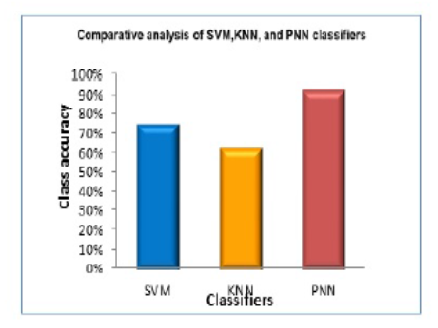


Indian Journal of Science and Technology
Year: 2023, Volume: 16, Issue: 17, Pages: 1284-1294
Original Article
Parashuram Bannigidad1, Namita Potraj1*, P M Gurubasavaraj2
1Dept. of Computer Science, Rani Channamma University, Belagavi, 591156, Karnataka, India
2Dept. of Chemistry, Rani Channamma University, Belagavi, 591156, Karnataka, India
*Corresponding Author
Email: [email protected]
Received Date:28 January 2023, Accepted Date:30 March 2023, Published Date:02 May 2023
Objectives: To study the determination and classification of Scanning Electron Microscopy (SEM) images of silver nanoparticles using digital image processing techniques and classifying the images using various machine learning classifiers namely; SVM, K-NN, and PNN classifiers. Methods: Segmentation techniques namely; Fuzzy C-Means (FCM) and K-Means were applied to extract geometric features from SEM images of silver nanoparticles. The size of nanoparticles was determined and classified based on various nano applications. The categorization of silver nanoparticles was done based on the geometrical feature value, i.e. area, and was further classified into three categories such as; 0-100 nm, 101-200 nm, and 201-500 nm using both the segmentation techniques. Further, the proposed method extracts texture features such as; kurtosis, skewness, and entropy and used SVM, K-NN, and PNN classifiers to classify the silver nanoparticle SEM images. The proposed results are analyzed and interpreted by chemical experts to observe the effectiveness of the proposed method. Findings: To improve the classification accuracy of Silver nanoparticle images, textural features such as; kurtosis, skewness, and entropy were extracted and SVM, K-NN, and PNN classifiers are used to classify the silver nanoparticle images. The performance of the proposed algorithm is evaluated based on performance evaluation measures such as; specificity, sensitivity, true predictive value, and false positive value. Higher TPV, specificity, and sensitivity values show promising results. It is observed that the SVM classifier has 75.00%, K-NN has 62.50%, and PNN yielded an accuracy of 93.00%. Novelty: Traditional synthesis and characterization techniques are inefficient and time-consuming and require more space and infrastructure to analyze the size of the nanoparticle. The current study circumvents these limitations. The silver nanoparticle images used in the present study are synthesized using rudanti fruit seeds, and the process is named as green synthesis process or biological method. This method is widely used because it does not use anytoxic chemicals, is inexpensive, andis environmentally friendly. In the previous work, only geometrical features namely; Area (pore size), and range-wise pore size were calculated depending on the application-oriented. The present study employs two phases; the training phase (knowledge base) and the testing phase(classification). The training phase includes segmentation, feature extraction, and categorization depending on the applications. The testing phase extracts the textural features such as; kurtosis, skewness, and entropy, and classifies the silver nanoparticles by using SVM, K-NN, and PNN classifiers.
Keywords: Silver nanoparticles; Image segmentation; FCM; KMeans; SVM; KNN; PNN
© 2023 Bannigidad et al. This is an open-access article distributed under the terms of the Creative Commons Attribution License, which permits unrestricted use, distribution, and reproduction in any medium, provided the original author and source are credited. Published By Indian Society for Education and Environment (iSee)
Subscribe now for latest articles and news.